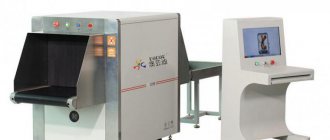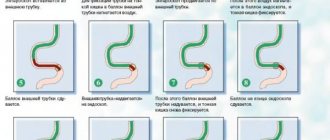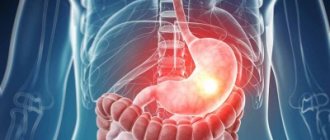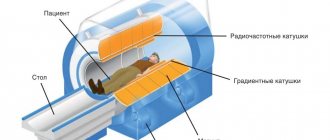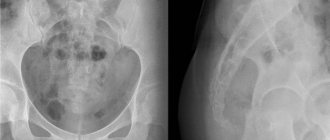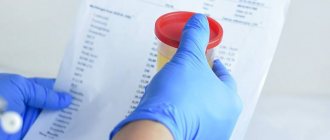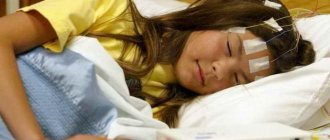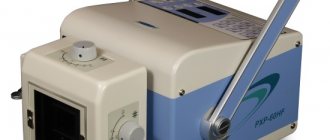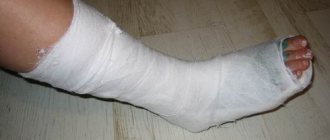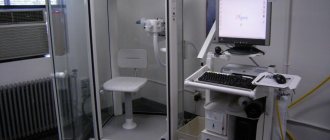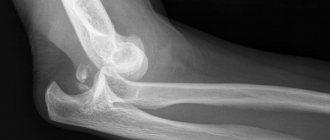Rectosigmocolonoscopy is the most accessible effective method for diagnosing intestinal diseases. The diagnostic procedure allows you to examine the mucous membrane of the colon, sigmoid and rectum. Although the procedure is somewhat uncomfortable and painful, it provides important information for the doctor and the patient - it allows you to detect pathologies that are not visible either with x-rays or with ultrasound.
The procedure is performed using an endoscope. This is a flexible tube with a light source at the end and a hollow tunnel for the forceps. Forceps are used to take biopsies and remove polyps, if necessary.
Colonoscopy methods
Colonoscopy is the general name for methods of examining the intestines. All of them are carried out using an endoscope and require mandatory direct preparation. The difference is in the parts of the intestine that are examined during the procedure.
These studies are used to examine the colon if there is a suspicion of its pathology (colitis, diverticula, Crohn's disease, etc.)
In medical practice, the following methods of intestinal diagnostics are distinguished::
- Rectosigmocolonoscopy is an option when a diagnostic examination of all parts of the intestine is performed, except the small intestine.
- Rectosigmoidoscopy - only the rectus and sigmoid sections are examined.
- Rectoscopy - only the rectum is examined.
What is a sigmoidoscope?
The device for performing rectoscopy is a tube made of medical metal, which is equipped with a lighting and air supply system. The latter is necessary so that the folded surface of the intestinal mucosa straightens, and the doctor can examine the sites of its damage. A rectoscope, or sigmoidoscope, can have different diameters (up to 2 cm) and length.
After the intestinal walls have straightened, a video camera is inserted into the tube. Today, devices for intestinal diagnostics are equipped with fiber optics, which display the surface of the intestine on a monitor, allow you to record the received video data and perform minimally invasive operations in real time.
A sigmoidoscope can be rigid or flexible. In addition, it is possible to use disposable devices.
Indications for passing
Testing may be required:
- as a preventive examination of intestinal cancer;
- to make a diagnosis;
- as an understanding of the characteristics of the course of the disease, for the most accurate choice of treatment;
- to assess the effectiveness of current treatment;
- to take material for histology.
Symptoms that may be a reason for the procedure:
- pain in the gastrointestinal tract;
- bubbling;
The colonoscopy procedure is performed to more carefully select the patient’s treatment.
- heaviness in the rectal area;
- frequent cases of flatulence;
- difficulty passing stool;
- a persistent feeling of fullness in the intestines after using the toilet;
- bloating;
- pain during bowel movements;
- anemia;
- signs of blood in the stool;
- rectal bleeding;
- chronic constipation;
- false urge to defecate;
- regular diarrhea;
- repeated vomiting;
- detection and extraction of foreign objects;
- sudden or increasing loss of appetite;
- causeless weight loss.
Preventive examination is recommended for people over 45 years of age. It is advisable for them to undergo the study once every 5 years. If there are frequent cases of intestinal cancer in the family, then it is better to undergo a rectosigmocolonoscopy procedure once every 2-3 years.
An emergency study is also prescribed to determine the source of bleeding.
Who is referred for diagnosis?
Indications for sigmoidoscopy are for patients with complaints such as:
- long-term constipation, diarrhea, the cause of which is difficult to determine;
- bleeding from the anus;
- the presence of uncharacteristic discharge from the rectum - pus, mucus;
- pain in the anal area.
The gynecologist will refer a patient with vaginal tumors for sigmoidoscopy to determine whether the tumor has invaded the rectum. A urologist will recommend proctoscopy for patients with prostate tumors.
RRS is recommended for all adults after 40 years of age every 5 years for early detection of malignant tumors.
Contraindications
There are a number of diseases in the presence of which rectosigmocolonoscopy is not recommended:
- myocardial infarction;
- pregnancy;
- severe form of heart and lung failure;
- cerebrovascular insufficiency;
- wide foci of ischemic colitis;
- acute inflammatory processes in the examination area;
- the first few weeks after surgery;
- painful occurrence of adhesions;
- relapse of ulcerative colitis;
- severe bleeding disorders;
- progressive peritonitis;
- in case of risk of heavy bleeding.
Contraindications to sigmoidoscopy and colonoscopy
Contraindications to sigmoidoscopy:
- cardiovascular diseases;
- respiratory failure;
- vascular pathologies of the brain;
- severe inflammatory disorders: thrombosis of the hemorrhoidal vein, acute rectal fistula, anal fissure.
Colonoscopy is not prescribed for patients diagnosed with infectious diseases and blood diseases, heart or pulmonary failure, peritonitis, ulcerative or ischemic colitis.
How is rectosigmocolonoscopy performed?
Typically, a rectosigmocolonoscopy takes approximately half an hour. Sometimes the procedure can take about 45 minutes if additional manipulations are required.
The procedure is painless and allows you to obtain maximum information about the condition of the organ.
The research involves a certain algorithm:
- The couch is covered with clean bedding.
- The person changes into a robe or a special cape.
- The procedure is performed lying down. The subject is turned on his left side, legs bent at the knees.
- The subject breathes deeply through his mouth. The doctor inserts an endoscope lubricated with Vaseline into the anus, taking into account all the anatomical features of the intestine.
- The intestine is inflated with air. This is necessary for the best inspection of the walls.
- While the device is advanced, the specialist evaluates the intestines. Sequentially - straight, sigmoid, colon.
- If required, a biopsy is taken for histology.
- After completion, the subject is allowed to lie down for some time to allow excess air to escape.
The technique of performing rectosigmocolonoscopy for children does not differ much from the examination of adults, except for reducing the preparation period to two days. Upon completion of the procedure, the child is under the supervision of a medical professional for about an hour to eliminate the side effects of being under anesthesia.
After the test, you may feel discomfort for several days. This is nothing to worry about and is completely normal.
During colonoscopy, the patient lies on his side or takes a knee-elbow position.
In such studies, three main types of anesthesia are used - sedation, local and general. The choice of pain relief method depends on the indications for the examination, how the body tolerates different types and drugs, as well as the individual wishes of the person.
General anesthesia is usually prescribed:
- for children, to avoid psychological trauma due to the peculiarities of the procedure;
- with inflammatory processes of the large intestine;
- after surgery on the pelvic organs;
- those suffering from neoplastic diseases of the uterus or prostate;
- having multiple intestinal adhesions.
Possible complications
From a medical point of view and diagnostic value, of course, colonoscopy is considered the best option, since with its help you can carefully examine the entire intestinal mucosa and identify many pathologies in the initial stages. But due to the immersion of the patient in drug-induced sleep and dulling of his sensitivity, there is a possibility of mechanical damage to the mucous membrane by the colonoscope.
With sigmoidoscopy, the likelihood that this could happen is reduced to zero. Firstly, the device is not inserted deeply and the doctor can better control its movements, and secondly, the subject is fully conscious and in case of the slightest discomfort he will immediately notify the diagnostician.
What can a bowel test reveal?
In a normal state, the mucous membrane is pale pink, the lumen is not changed, the wall is elastic, shiny, smooth with a clear vascular pattern.
The surface of the mucous membrane indicates changes in the organ that can lead to problems
Potentially, during diagnostic rectosigmocolonoscopy it is possible to identify:
- internal hemorrhoids;
- cracks;
- adhesions;
- abscesses;
- dystrophic process;
- erosion;
- fistulas;
- scarring;
- signs of infectious diseases;
- presence of obstruction;
- detection of foreign objects.
Sigmoidoscopy and colonoscopy: description of procedures, main differences
Sigmoidoscopy is a research method with which it is possible to examine the distal segment of the colon at a distance of 30 centimeters from the anus. This method was discussed in his article by V.P. Zemlyanoy, T.N. Trofimova, S.L. Nepomnyashchaya, T.V. Dementieva. The essence of the manipulation: a sigmoidoscope is inserted into the patient's rectum through the anus, and the doctor examines its walls, studies the vascular pattern, the nature of folding, the color, shine and elasticity of the mucous membrane, and evaluates the presence of pathologies and the tone of the intestine.
Colonoscopy is a highly informative instrumental research technique that allows you to examine the entire large intestine and the final section of the small intestine. Today, colonoscopy is considered the “gold standard” for diagnosing most intestinal diseases. The examination is performed using a colonoscope instrument. A flexible tube with a diameter of up to 8 mm is equipped with small video cameras, a powerful white light bulb, and a side channel through which additional manipulators are inserted if necessary. The cameras transmit an enlarged image to the monitor screen, which allows you to examine in detail the entire surface of the mucous membrane.
The main differences between sigmoidoscopy and colonoscopy:
- volumes of diagnostics (colonoscopy is considered to be a more informative method);
- possibilities of the procedure (during colonoscopy, a biopsy can be taken for further study of the material);
- carrying out manipulations with various instruments.
The main difference between sigmoidoscopy and colonoscopy is that colonoscopy can be used as a therapeutic procedure, since with the help of a colonoscope it is possible to excise various tumors, coagulate blood vessels and eliminate stenosis of the colon.
Diseases detected by the procedure
The examination reveals a number of diseases that cannot be diagnosed by other means. Among them are diseases such as:
- Crohn's disease;
- benign neoplasms;
- intestinal cancer;
Polyps are tumor-like benign neoplasms. During the procedure, the specialist can remove the polyp with a special loop
- polyposis;
- intestinal tuberculosis;
- colitis;
- multiple diverticula (protrusions);
- typhlitis - inflammation of the cecum;
- pathologies of organic development of the lower gastrointestinal tract.
How to choose the optimal examination option?
Knowledge of all the features of diagnostic tests allows the patient to avoid complications in unforeseen circumstances, properly prepare for procedures and choose the best conditions for the procedure. But this is where the powers of the patients end, and everything else should be decided by a specialist with the appropriate education.
Only he or a medical council can make decisions regarding the choice of the optimal type of diagnostics to establish a diagnosis for certain symptoms. Therefore, the question is not raised which examination is better for any reason, but its feasibility for a given pathology is taken into account.
Diagnostic examination of the intestine is an affordable and effective way to identify many diseases of the rectum and colon in the early stages. This can be done through two informative procedures. Colonoscopy differs from sigmoidoscopy in the depth of penetration of the device, the subjective sensations of the person, and the duration of the preparatory stage. Therefore, the doctor individually decides which examination is most appropriate for each patient.
How to prepare for the procedure?
Typically, rectosigmocolonoscopy is performed in the first half of the day. It is advisable to take a clean cloth or diaper, as well as replacement shoes.
During the period of two to three days before the test, it is important not to eat:
- black bread;
- poultry (except chicken), pork;
- legumes;
- mushrooms;
- porridge - barley, corn, oatmeal, pearl barley and wheat;
- smoked meats, canned food, sausages;
A few days before the colonoscopy, the patient is prescribed a special diet, which involves cleansing the intestines of toxins.
- marinades;
- greens (including lettuce), cabbage, beets, carrots;
- berries, fruits, dried fruits;
- milk, cheese, sour cream;
- nuts, seeds;
- sweets and baked goods;
- chocolate;
- any alcohol;
- coffee, rich tea;
- kvass and carbonated drinks.
It is not advisable to fry foods or over-salt them.
Allowed to eat:
- chicken;
- eggs;
- fish;
- vegetable soups, light broths;
Preparing the patient for rectosigmoidoscopy
Preparation for the study is the most important point in ensuring its effectiveness and safety for the patient. As a rule, preparation begins two days before rectosigmoidoscopy and requires a special diet and colon cleansing.
No later than two days before the procedure, it is necessary to exclude from the diet all foods that increase gas formation and the intensity of fermentation in the intestine. Such foods include legumes and dishes made from them, foods high in fiber (vegetables and fruits), and a number of cereals (millet, pearl barley, etc.). The patient also needs to exclude bread, flour and confectionery products, carbonated drinks, etc. from food. It is allowed to eat boiled lean meat (fish, chicken), rice porridge, and drink weak tea with crackers. On the day of the study you must refuse to eat. It is possible to drink only ordinary clean water.
Device for performing a cleansing enema
The day before the examination, it is necessary to cleanse the colon. For this purpose, either a regular enema or modern medications are used. When choosing an enema, it is necessary to administer it twice - in the evening before the test and in the morning, several hours before the procedure.
The use of laxatives is a more modern approach. The most commonly used drugs are Fortans, Lavacol or Flit. The drugs are available in the form of a dry substance or a gel-like substance in packets that must be prepared immediately before use. The effect occurs within a few hours. In this case, a high degree of cleansing of the colon is achieved without the use of enemas, which are always associated with great discomfort for a person. Before using such drugs, you must ensure that there are no allergic reactions and tolerability of their components.
The regimens for using each medication differ from each other. You must carefully read the instructions for the drug and consult a specialist.

